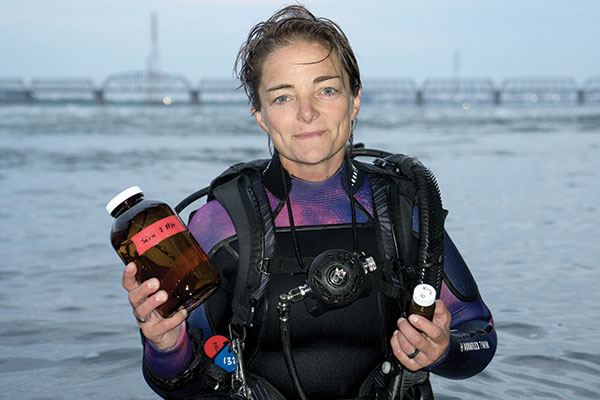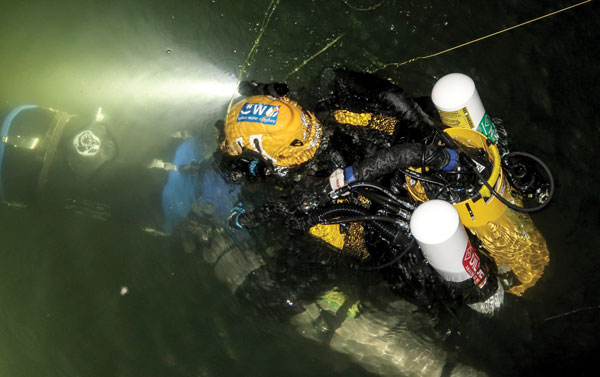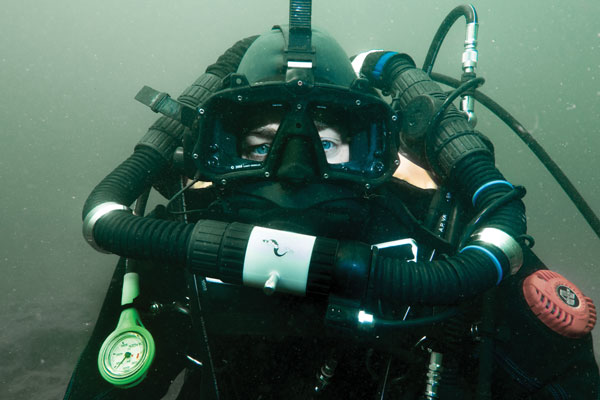Urban Water Odyssey
Words by Nath Lasselin
Going with the flow raises awareness of drinking water health

It was Friday morning, around 7:00 am. I was all geared up, with my drysuit, my latex hood, my modified Kirby Morgan full face mask, communication system, rebreather, tanks, computer, scooter and all kinds of redundant equipment. I looked like an Aquanaut on a mission. The sun was rising, promising to be another beautiful day of a particularly hot and sunny summer. It was almost time to jump in the brownish-green water of the St Lawrence River in Montreal, Quebec. My team on the boat was ready to assist and my topside team supervisor about to give me directions.
We made sure – for the 3rd or 4th time – I had all I needed and we were really ready for this Urban Water Odyssey. I will never forget the last moment before I hit the water, my feelings a mix of excitement and apprehension. The rest of my journey would be out of my control. I would have to go with the flow.
For more than a year I had planned that 44 mile (71km) journey along the shores of Montreal in order to raise awareness towards fresh water. This was a project dear to my heart. After exploring caves all over the world and as far away as China, after facing the harsh environment of the North West passage in the Canadian Arctic, I was about to face the biggest, most complicated project of my life, just 20 minutes from downtown Montreal, my home. An extreme expedition so close to the city.
Diving the St Lawrence wasn’t new to me. I enjoy diving many of the well-known wrecks like the Jodrey or the Empress of Ireland and even some wrecks that nobody dived before a TV show called Wrecks Hunters (a Quebec TV show, by the way) came along. What was new was that I would be diving in a portion of the river where…well, let’s just say it I wouldn’t call it a hot new dive spot. In most of it the visibility is less than four feet (1.2m), the current can be as strong as seven knots, and you need to pass under eight bridges (including one under construction) and over two tunnels. And that’s not counting the fact that it’s a major seaway. And then there’s the rapids – you know, the ones that stopped the Europeans three centuries ago and forced them to build locks.

Driven to dive
So what’s fun about that? More than fun, it just felt like something I had to do. You know that day when you ask yourself: when I’m old and I think about the things I could have done but didn’t even try, how will I feel about it?
For years, each time I came back home from one of my shoots or expeditions, as the plane flew in over the river, I’d wonder what it would be like to dive the shore of Montreal. What would I encounter? There are supposed to be more than 73 different species of fish plus all the aquatic plants. What do we really know about it? But when you look at it from above, it’s the opposite of the inspiring blue of the ocean. It is not an appealing invitation, the type that you want to accept right away. But 80% of the drinking water for the city of Montreal comes from that same body of water and all sewage water (after treatment) goes back into it. In the 70’s and 80’s we had a lot of PCB problems, like in so many rivers all over the world. Nowadays that problem seems to be widely fixed, but how good is the water? Are we really taking a good care of it? And more specifically, how is its health, regarding emerging contaminants? You know, like pesticides, herbicides, by products of drugs, ibuprofen…. How much do, we, as individuals, put back in our drinking water? Nobody knows the effect it will have on us in a decade or two. One thing I do know for sure is that without proper safe drinking water humans will not survive much more than three days, five at the outside. Good fresh water is the most important resource on the planet. We depend on it. And everything we put in our rivers…well, it goes from one river to the next one, and then to the oceans.
I am lucky enough to have been a witness of the changing conditions in the Arctic, and the caves and oceans of the world. As humans, we have this mindset that what we don’t see doesn’t really exist, and so few people have the chance to become a diver and so witness firsthand the beauty and the fragility of our world.
The Urban Water Odyssey began to haunt me. I could not keep silent anymore and do nothing. I had to act. In 2017, I decided to do a 13.1 mile (21.1km) proof-of-concept dive to see if I could do it and what I would possibly face. What kind of equipment, logistic, preparation, physical and mental fitness I would need? Putting on an expedition like this one was complex because of the nature of the river. Despite the use of multiple scooters, rebreathers, and bailout, it would take more than 30 hours in the water, hoping nothing would fail and, more importantly, I had to put together several different chase boat teams since no boat could do the whole trip length because of the rapids and shoals. Only a small boat with turbine engine and excellent, experienced pilot could follow me.
Finally, after months of preparation, I had to let go of control completely, and rely only on the information from the surface to know exactly where to go. With a small crew, we tested all the difficult parts of the rivers. After more than six months of research, doing rafting, kayaking, and visiting the rapids, I finally met the perfect captain and boat, from which I was able to make the first dive ever through the rapids, and came out without a scratch. After the success of the proof-of-concept dive and all of the equipment tests and adjustments, I put together a bigger team of partners and divers. Companies like KISS, which modified one of my Evolution canisters to warm it up to be more comfortable during my long dive. With the collaboration of amazing individuals and businesses, I was confident I could make it.

Team project
For the first hours in the water, everything went so smoothly, as planned, my pace was nearly perfect. Until…yes, that infamous “until”…! I always feared the thing I didn’t think about. I remembered the story of an ultra-marathoner who once forgot his sunscreen and I before the dive I wondered which little detail would be my nightmare. After four hours in the water, my progression was so slow I was basically stuck. It was a beautiful Friday morning, probably the last one of summer and it felt like everybody was on the water – so many boats that my topside team leader had to deviate my route away from the channel. From the air, it looks like we have a lot of water in Montreal but the river is anything but deep. I ended up having to dive in less than nine feet (2.75m) for hours, getting stuck in aquatic plants that reached from the bottom to the surface. It was a bit like scootering in a jungle. I had to stop frequently to clean the propellers of the scooter. I even lost one of the props. The scooter batteries were dying fast and everything looked to be against us. After ten hours of underwater lawn mowing, it was clear I wasn’t going to be able to go through the rapids before sunset. Some other issues with different pieces of equipment added to the equation. After fifteen hours in the water, the surface team told me it was no longer safe to keep going and they were taking me out of the water.
I had two options. I could stay down no matter what, running out of human and equipment resources and putting others at risk. I asked myself, what is the goal of the project? To make a single 44-mile (71km) dive, or to raise awareness of fresh water? The answer was simple. I didn’t know what the surface team had had to face during the day and the exact status of the situation. Who was I to put my team at risk?
I chose to comply.
What at first felt like a heart breaking decision became a unifying one. Since almost the beginning of the day, we had faced hour after hour of adversity and everyone had worked together towards the same goal. It was not just my project anymore. It became my team project and the project of every single person following the adventure. The goal was to go from point A to point B, staying humble, safe, and intelligent enough to adapt to the new reality we were facing.
We took a short break. It was a night without sleeping for me, of course. The next day we were able to continue the journey. The minute I went back in the water, I felt at home. When I arrived at the rapids, I was so happy to be there. Nearly one third of the route was not open to regular navigation. The lack of information on the charts made it virgin territory. At least here, no matter the weather, boat traffic was not an issue. I felt like a single drop of water being pushed by the heavy currents, avoiding rocks and listening to the navigation information given in order to avoid being crushed against the bridges.
Everything was great until noon, when it was another great sunny day on the river with lots of boat traffic. That day it took 15 hours in the water to reach the finish line late in the evening.
When we arrived, people were waiting on the dock to welcome us. We invited them to join us at home to celebrate. We were all tired but we stayed up late that night. We were so proud to have finally made it. No matter how weak or strong we are, no matter how bad a situation can become, by sticking together, listening to others, and adapting, we can do it.

The Odyssey continues
The Urban Water Odyssey was not just about the big dive. There were two other things I wanted to achieve. One was to establish regular cleanups of the river in Montreal with other divers. Each outing, as we remove debris from the water, we meet so many people and get a chance to talk with them about preservation and daily choices we can make. The second one goal was to take sediment and water samples to be analyzed by researchers at University of Montreal for emerging contaminants. I dived from Rockport, Ontario, to Trois-Rivières, QC, making more than forty stops in that 220 mile (350km) distance to have a better idea of the situation. Final results of the analyses will be made available early 2019 but what we already know is that caffeine and drugs of all kind are present in our river and tap water. Contaminants thrown away in the toilet or sink instead of the garbage, or simply from our urine because of what we eat and drink, and the drugs we consume.
The good news from this is that we have the power to change things through our daily choices. We can make our own environment a better one, where water will be preserved. There is so much we can do. By sharing our love and concern for the underwater world, we can help enlighten people around us. For my part, I plan to continue to dive in the St Lawrence, documenting the blue gold we so depend on.
Leave a Comment







